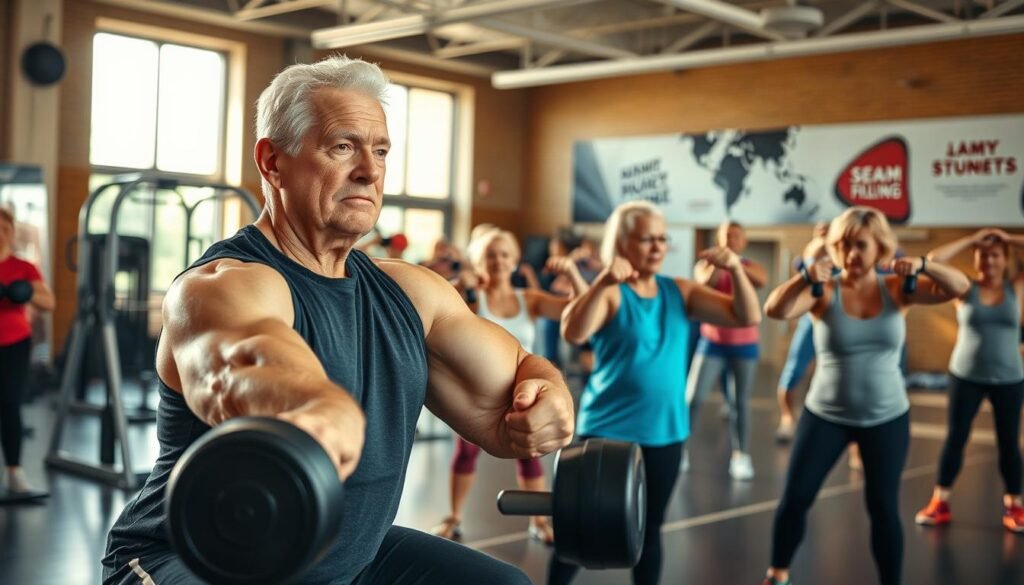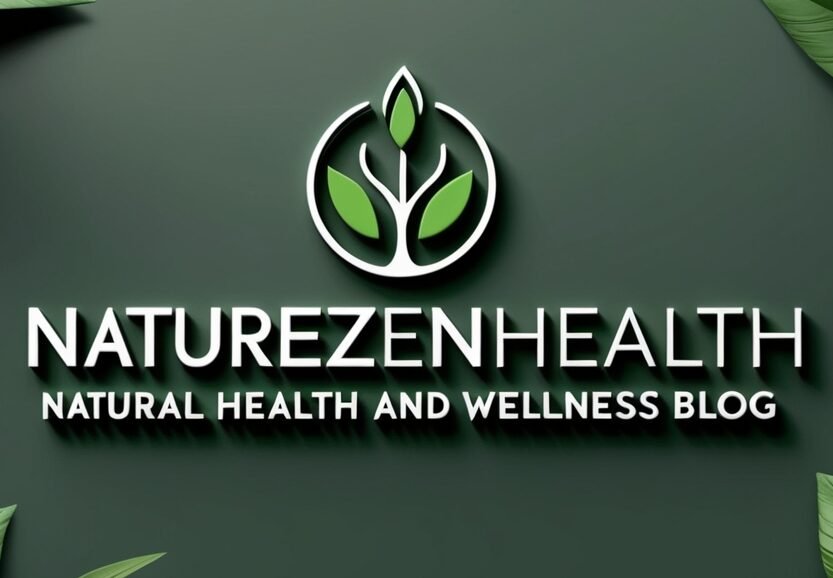Can regular physical activity really be the key to a longer and healthier life? As we age, our bodies change a lot. This can affect our overall well-being, like our physical strength and brain function.
Adding daily movement to our routines can make a big difference. It can improve both longevity and brain health. This way, people can live better lives and lower the risk of age-related diseases.
Studies have found that regular exercise boosts both physical and mental health. It helps lead to a more rewarding life.
Key Takeaways
- Regular physical activity improves overall health and well-being.
- Incorporating daily movement can enhance longevity.
- Physical activity has a positive impact on brain health.
- A healthy lifestyle can reduce age-related disease risks.
- Daily movement improves quality of life.
The Connection Between Movement and Longevity
Studies show that moving your body is key to living a long, healthy life. As more people live longer, it’s vital to understand what helps us stay healthy. Movement is a big part of that.
Understanding Longevity
Longevity means living a long, healthy life. It’s shaped by genes, lifestyle, and environment. Physical activity is a big lifestyle factor that affects how long we live.
Research shows that moving regularly can lower the risk of serious diseases. This includes heart disease, diabetes, and some cancers. This can lead to a longer, healthier life.
The Role of Physical Activity
Physical activity is crucial for staying mobile and healthy as we age. It helps in many ways:
- Improves heart health
- Keeps muscles strong
- Boosts flexibility and balance
- Supports bone health
Key Studies on Movement and Lifespan
Many studies have looked into how movement affects lifespan. These studies offer insights into physical activity’s role in longevity.
| Study | Findings |
|---|---|
| A 2019 study published in the Journal of Aging Research | Found that regular physical activity was associated with a reduced risk of mortality in older adults. |
| A 2020 review published in the Journal of Sports Sciences | Concluded that physical activity can help to promote healthy aging by reducing the risk of chronic diseases. |
| A 2018 study published in the Journal of Gerontology | Discovered that older adults who engaged in regular physical activity had improved physical function and mobility compared to those who were sedentary. |
These studies highlight the importance of physical activity for a long, healthy life.
Impact of Daily Movement on Brain Health
Daily movement greatly benefits our brain health. Regular exercise boosts our brain’s function and health.
Exercise is key to a healthy life, and it’s good for our brain too. Studies show it improves our thinking, mood, and brain health.
Neuroplasticity and Exercise
Neuroplastic neuroplasticity means our brain can change and adapt with age. Exercise helps our brain grow and change, making it stronger.
Research shows exercise helps grow new brain cells and connect them better. This is great for people with brain diseases, as it can slow them down.
Reducing the Risk of Cognitive Decline
Regular exercise lowers the risk of losing brain function. It’s linked to less chance of getting dementia or Alzheimer’s.
A study in the Journal of Alzheimer’s Disease found exercise helps older adults keep their brain sharp. It’s key for keeping our brain healthy.
| Exercise Type | Cognitive Benefit |
|---|---|
| Aerobic Exercise | Improves cognitive function |
| Resistance Training | Enhances cognitive health |
| Flexibility Exercises | Supports overall brain well-being |
Daily movement is vital for our brain health. Adding regular exercise to our day helps keep our brain sharp and reduces decline risk.
Active Lifestyle Tips for All Ages
Moving more can greatly improve health at any age. Adding physical activity to daily life boosts wellbeing. It sets the stage for a healthier future.
Incorporating Movement into Daily Routines
Making movement a part of daily life is easy. Try taking the stairs, walking to work, or doing chores with energy. Starting small is key; even a short walk at lunch can help.
Busy schedules can make exercise hard. But, incorporating activity into daily routines works. Try moving during TV breaks or squats while brushing teeth. The aim is to make movement a daily habit.
Best Exercises for Longevity
For long life, mix aerobic, strength, and flexibility exercises. Aerobic exercises like walking or swimming boost heart health. Strength training keeps muscles and bones strong. Flexibility exercises like yoga improve mobility and lower injury risk.
- Brisk walking or jogging
- Swimming or water aerobics
- Cycling or using a stationary bike
- Yoga or Pilates for flexibility
Setting Achievable Fitness Goals
Setting realistic fitness goals keeps you motivated. Goals should be specific, measurable, achievable, relevant, and time-bound (SMART). For instance, aim to walk for 30 minutes, three times a week. This is more doable than just wanting to be more active.
Don’t forget to celebrate small wins. Acknowledging progress, no matter how small, boosts your drive to reach bigger fitness goals.
The Science of Anti-Aging Through Movement
The science of anti-aging through movement is complex. It involves many physiological processes that help us live longer and healthier. As we age, our bodies change in ways that can impact our health.
How Exercise Slows Biological Aging
Exercise is key in slowing down biological aging. It helps keep telomeres long, reduces oxidative stress, and boosts cellular function. Telomeres protect our chromosomes and naturally shorten with age. But, studies show that exercise can help keep them longer, slowing aging.
Key Mechanisms:
- Telomere maintenance
- Reduction in oxidative stress
- Enhanced cellular function
Hormonal Benefits of Regular Exercise
Regular exercise offers many hormonal benefits for anti-aging. It affects hormone production and regulation, like IGF-1, growth hormone, and cortisol. Exercise helps keep these hormones in balance, improving health and reducing age-related disease risk.
The impact of exercise on hormone regulation is multifaceted:
| Hormone | Effect of Exercise | Benefit |
|---|---|---|
| IGF-1 | Increased production | Cell growth and repair |
| Growth Hormone | Enhanced secretion | Muscle strength and bone density |
| Cortisol | Regulated levels | Reduced stress and inflammation |

Understanding the science behind anti-aging through movement helps us use exercise to improve our healthspan and longevity.
Benefits of Aerobic Exercise
Aerobic exercise is key to a healthy life, boosting both physical and mental health. It does more than just keep you fit. It also improves mental clarity and cardiovascular well-being. Activities like walking, cycling, or swimming can greatly enhance your health.
Enhancing Mental Clarity
Aerobic exercise boosts mental clarity by increasing blood flow to the brain. It also helps grow new brain connections. This can make you more focused and improve your memory.
Research shows it can also lower anxiety and depression symptoms. This makes your mind feel better.
Boosting Cardiovascular Health
Aerobic exercise is great for your heart and blood flow. It strengthens your heart and makes blood flow better. This can lower your blood pressure and reduce heart disease risk.
It also improves how well your body transports oxygen to muscles. This is just one way it helps your heart and blood vessels.
| Benefits | Description | Impact |
|---|---|---|
| Mental Clarity | Improved blood flow to the brain | Better concentration and memory |
| Cardiovascular Health | Strengthened heart and improved blood flow | Lower blood pressure and reduced heart disease risk |
In short, adding aerobic exercise to your daily routine can greatly benefit your mind and heart. It leads to a healthier, more balanced life.
Strength Training for Longevity
As we get older, strength training becomes key for staying physically fit and living longer. Doing regular strength exercises boosts muscle and improves health.
Importance of Muscle Mass Retention
Keeping muscle mass is vital. It affects our metabolism, bone health, and how well we can move. People with more muscle tend to be healthier and less likely to get chronic diseases.

Recommended Strength Exercises
Adding different strength exercises to your routine helps keep muscle and supports longevity. Here are some good ones:
- Squats: Works many muscles, boosting lower body strength.
- Deadlifts: Increases muscle and strength overall.
- Bench Press: Targets upper body, strengthening chest, shoulders, and triceps.
- Rows: Builds back and arm muscles.
Start with weights you can handle and slowly add more as you get stronger.
Mind-Body Connection: Movement and Mental Wellbeing
Understanding the mind-body connection is key to seeing the benefits of daily movement. It shows how physical activity and mental health are linked. Practices like yoga and meditation boost wellbeing.
The mind-body connection is about how the brain and body work together. Physical activity can help mental health. It can lower stress and anxiety and improve mood and thinking.
Yoga and Its Longevity Benefits
Yoga is a practice that connects the mind and body. It includes physical poses, breathing, and meditation. Yoga offers many benefits for a long and healthy life.
- Improved flexibility and balance, reducing the risk of falls and injuries.
- Enhanced cardiovascular health, through practices that lower blood pressure and improve circulation.
- Reduced stress and anxiety, promoting mental wellbeing and resilience.
Regular yoga practice improves physical and mental health. It leads to a longer, healthier life.
The Role of Meditation in an Active Lifestyle
Meditation strengthens the mind-body connection, offering many health benefits. It can be part of an active lifestyle. Meditation helps in many ways.
- Enhance mental clarity and focus, improving performance in physical activities.
- Reduce chronic stress, which is linked to various health conditions, including cardiovascular disease and diabetes.
- Promote recovery, helping the body to heal and adapt to the demands of physical activity.
By mixing physical movement with yoga and meditation, people can strengthen their mind-body connection. This improves overall health and wellbeing.
Staying Active as You Age
Staying active as you age can greatly improve your life. Older bodies change, affecting how you move, how strong you are, and how flexible you are. But, with the right steps, seniors can stay active and healthy.
Overcoming Mobility Challenges
Seniors often face mobility issues due to age-related changes. These changes include less muscle, weaker bones, and stiffer joints. To beat these challenges, it’s key to add exercises that boost strength, flexibility, and balance to your daily life.
Resistance training is great for keeping muscles and bones strong. Squats, lunges, and leg presses are good, but make sure they fit your fitness level and health.
Adapting Workouts for Senior Health
It’s vital to tailor workouts for seniors. Choose low-impact exercises to avoid injuries but still keep you moving. Water-based exercises, like swimming or water aerobics, are perfect because they’re low-impact and work your muscles.
Adding flexibility and balance exercises, like yoga or tai chi, can also help. They improve your mobility and lower fall risks. Plus, they help your mental health by reducing stress and boosting your mood.
Seniors should also do functional training. This means exercises that help with everyday tasks, like standing up from a chair or climbing stairs. It boosts your independence and quality of life.
Conclusion: Embracing Movement for a Healthier Future
Incorporating daily movement into your routine is key for a longer life and better brain function. An active lifestyle boosts your overall well-being.
Key Takeaways
Daily movement increases lifespan, sharpens the mind, and lowers disease risk. Simple changes, like aerobic exercises or strength training, greatly impact your health.
Starting Your Journey
Starting an active lifestyle is about taking small, doable steps. Set realistic fitness goals and pick exercises you like. This makes daily movement a fun and lasting part of your life, leading to a healthier future.



